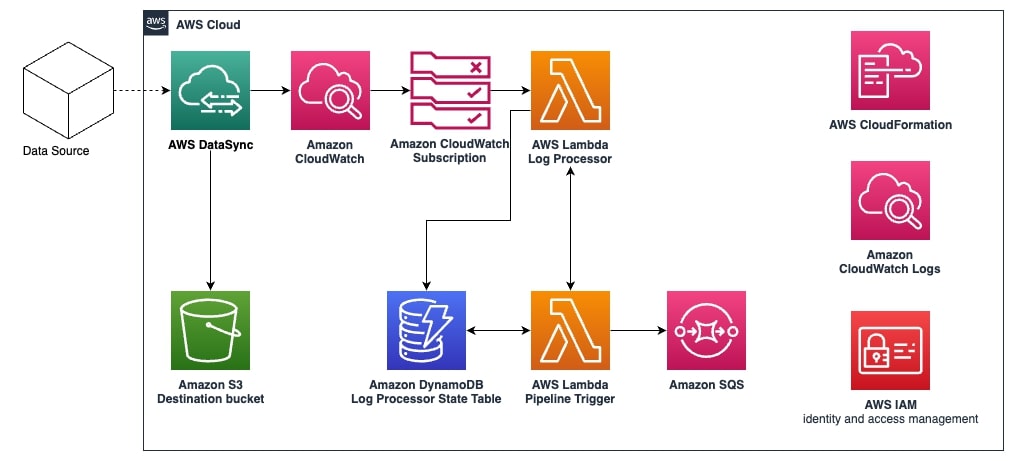In this digitally-driven international, where facts are the lifeblood of groups, the efficient switch of massive datasets is paramount. Cloud computing, in particular Amazon Web Services (AWS), has revolutionized the manner agencies manage and shop information. AWS DataSync emerges as a key participant in this panorama, imparting a secure and streamlined solution for moving terabytes of data to and from AWS garage offerings.
Overview of AWS DataSync:
AWS DataSync is a secure and green online information transfer carrier provided by Amazon Web Services (AWS), designed to simplify, automate, and boost up the copying of big datasets to and from AWS storage offerings. This robust answer caters to the evolving needs of agencies in coping with huge volumes of facts within the cloud.
The setup process entails developing agents that act as intermediaries, deploying them to preferred locations, and choosing carrier endpoints such as Amazon S3, Amazon EFS, or Amazon FSx. AWS excels in automation, allowing for real-time transfers or scheduled duties primarily based on particular intervals. The carrier boasts key safety functions, including encryption of statistics at relaxation and in transit, in addition to automated coping with community bandwidth disasters.
With a focus on scalability and compatibility with diverse garage answers, AWS presents a continuing facts switch revel. Its potential to automate responsibilities, monitor progress, and optimize costs makes it a useful device for corporations undergoing big-scale fact migrations, enforcing non-stop records replication for catastrophe restoration, or working in hybrid cloud environments. In essence, AWS emerges as a dependable solution, ensuring the green, steady, and well-timed switch of data inside the AWS atmosphere.
Getting Started with AWS DataSync:
Sign in to the AWS Management Console:
- Access the AWS Management Console for the usage of your AWS credentials.
- Ensure that you have the essential permissions to apply for AWS.
Navigate to the AWS Console:
- Once signed in, navigate to the AWS console to get the right of entry to the carrier’s capabilities and functionalities.
- The console gives a centralized interface for handling facts transfer tasks.
Create an AWS Agent:
- Agents are critical for records transfer tasks. Create an agent by specifying a unique call and an elective description.
- Agents act as the intermediary between your on-premises systems and AWS garage offerings.
Deploy the AWS Agent:
- After growing an agent, set it up in your preferred place. This can be an Amazon EC2 example or an on-premises server.
- Deployment ensures that the agent is ready to carry out records transfer obligations.
Choose a Service Endpoint:
- Select a provider endpoint that represents the AWS storage provider you need to apply, which includes Amazon S3, Amazon EFS, or Amazon FSx.
- This choice determines in which the records may be transferred to or from.
Activate the AWS Agent:
- Activate the agent with the usage of the activation key furnished during the agent introduction procedure.
- Activation establishes a stable connection between the agent and AWS DataSync.
Discover Your Storage:
- Initiate the storage discovery method to catalog and investigate the available data for the switch.
- Discovery offers insights into the shape and content material of your records.
Add Your On-Premises Storage System:
- Seamlessly combine your on-premises storage system with AWS using supplying essential information.
- This step permits AWS to interact with your local garage.
Start a Discovery Job:
- Launch a discovery activity to in addition explore and categorize the statistics available for transfer.
- The discovery activity assists in knowledge of the scope and characteristics of the data.
Configure and Start Data Transfer Tasks:
- Use the AWS DataSync console to configure records and switch duties primarily based on your requirements.
- Start the facts switch tasks to provoke the motion of records between supply and destination.
Clean-Up Resources (Optional):
- After successful records transfers, bear in mind cleansing up assets that might be no longer wanted.
- This step helps optimize AWS aid utilization and keeps your environment prepared.
Automation and Scheduling with AWS DataSync:
Real-Time Data Transfers:
- Configure AWS responsibilities for actual-time records transfers to make sure that changes are right now meditated.
- Ideal for situations in which the maximum up-to-date facts are essential.
Interval-Based Scheduling:
- Leverage interval-primarily based scheduling to automate information transfers at precise time durations.
- Define schedules primarily based on business needs, together with every day, weekly, or custom timeframes.
Flexibility in Scheduling:
- Enjoy flexibility by way of tailoring schedules according to precise requirements and workflows.
- Adapt the scheduling method based on various facts and transfer wishes.
Monitoring and Notifications:
- Leverage AWS’s monitoring capabilities to track the development of transfer duties.
- Configure notifications to obtain alerts for specific events or whilst predefined conditions are met.
Cost Optimization via Scheduling:
- Optimize prices via scheduling information transfers during intervals of lower call for or whilst information transfer costs are greater cost-efficient.
- Strategic scheduling enables maximizing aid utilization and limiting charges.
Security Features of AWS DataSync:
Encryption of Data at Rest and In Transit:
- Ensures comprehensive safety by encrypting facts each whilst stored at rest and all through transfer.
- Utilizes industry-trendy encryption protocols, safeguarding sensitive statistics.
Automatic Handling of Network Bandwidth Failures:
- Enhanced facts transfer resilience with the aid of automatically managing network bandwidth disasters.
- Ensures non-stop statistics transfer even in tough network situations.
Resume Transfer Capabilities:
- Includes the capability to mechanically resume records transfer duties from the point of interruption.
- Mitigates the impact of interruptions, contributing to information integrity.
Authentication and Authorization:
- Implements sturdy authentication mechanisms via AWS Identity and Access Management (IAM).
- Ensures that the best legal entities have to get admission to initiate and control records switch obligations.
Logging and Auditing:
- Provides distinct logs and audit trails of records transfer activities.
- Offers transparency for monitoring, auditing, and detecting any anomalies.
Key Features of AWS DataSync:
Speed and Efficiency:
- Optimizes facts transfer speed for quick and efficient motion of massive volumes of records.
- Accelerates switch times, lowering the general length of records migration or synchronization responsibilities.
Compatibility with Various Storage Solutions:
- Seamlessly integrates with Amazon S3, Amazon EFS, and Amazon FSx.
- Provides flexibility in choosing garage solutions primarily based on precise commercial enterprise requirements.
Monitoring and Logging Capabilities:
- Offers unique logs and metrics for real-time tracking of transfer speed, completion reputation, and mistake detection.
- Enhances visibility into statistics transfer sports for effective tracking.
Scalability:
- Scales seamlessly to accommodate developing facts transfer needs.
- Adapts to evolving commercial enterprise requirements without compromising performance.
Transfer Previews:
- Allows customers to preview statistics transfers before execution.
- Facilitates better plans and optimization by visualizing the impact on the target destination.
Benefits of Using AWS DataSync:
Time and Cost Savings:
- Automates statistics switch tasks, reducing the time and assets required for big-scale migrations.
- Minimizes manual efforts and associated costs, optimizing operational performance.
Simplification of Complex Tasks:
- Eliminates the need for custom solutions and repetitive guide methods.
- Provides a consumer-friendly interface for putting in place and handling data transfers, decreasing complexity.
Improved Reliability and Data Integrity:
- Ensures records integrity with capabilities like automatic managing of community screw-ups.
- Facilitates dependable statistics transfers even in challenging community situations, minimizing the chance of statistics corruption.
Flexibility in Data Transfer:
- Offers both real-time and scheduled switch alternatives, catering to numerous enterprise requirements.
- Adapts to various data transfer desires, supplying flexibility in managing workflows.
Enhanced Security Features:
- Implements strong security measures, which include encryption of statistics at relaxation and in transit.
- Adheres to compliance certifications consisting of HIPAA and GDPR, making sure records security and regulatory compliance.
Use Cases of AWS DataSync:
Large-Scale Data Migrations:
- Streamlines the migration of huge datasets to and from extraordinary storage solutions.
- Accelerates the facts migration method, lowering downtime and making sure of an easy transition.
Continuous Data Replication for Disaster Recovery:
- Facilitates actual-time or scheduled transfers to preserve updated copies of records.
- Ensures business continuity by way of offering a dependable catastrophe recovery solution with minimal data loss.
Hybrid Cloud Environments:
- Acts as a bridge between on-premises systems and AWS garage offerings.
- Enables seamless record transfers in hybrid cloud setups, assisting bendy and disbursed architectures.
Data Distribution for Content Delivery:
- Efficiently distributed multimedia content, software program updates, or digital assets.
- Enhances content material shipping workflows by ensuring timely and steady distribution.
Data Archiving and Backup:
- Simplifies archiving and backup processes for lengthy-term information retention.
- Provides a reliable solution for businesses requiring secure facts backup and archival techniques.
Pricing Model for AWS DataSync:
Data Transfer Pricing:
- Charges are based totally on the extent of statistics transferred into and out of AWS.
- Calculated for both transfers among on-premises structures and AWS storage offerings.
Data Transfer Acceleration:
- Additional price for organizations opting to apply Data Transfer Acceleration for faster transfers.
- Provides an accelerated records transfer option for situations wherein speed is vital.
Task Automation and Scheduling:
- No additional fees for automating tasks or scheduling habitual transfers.
- Organizations can leverage automation features without incurring extra expenses.
Monitoring and Logging:
- Monitoring and logging features are covered within the preferred pricing.
- Enables transparency into information and switches sports without additional charges.
AWS DataSync Agent:
- Creation and deployment of agents are protected in the fashionable pricing.
- Offers flexibility in creating and deploying dealers without incurring separate expenses.
Additional Tips:
- Cost Estimation: Utilize the AWS Pricing Calculator to estimate charges based totally on your unique information switch needs. This tool allows you to enter usage patterns and necessities for accurate pricing estimates.
- Continuous Monitoring: Regularly screen AWS DataSync switch activities and the usage of the supplied logs and metrics. This practice guarantees proactive control, early detection of troubles, and optimization of statistics switch workflows.
- Evaluate Data Transfer Acceleration: Assess the want for Data Transfer Acceleration primarily based on your switch pace necessities. While it incurs a further fee, it can appreciably decorate the rate of data transfers among on-premises structures and AWS storage.
- Explore Transfer Previews: Before executing facts switch responsibilities, leverage transfer previews to visualize the effect at the target destination. This can help in refining switch plans and avoiding potential errors.
- Utilize Compliance Certifications: If your organization has particular compliance requirements, leverage AWS’s compliance certifications, which include HIPAA and GDPR, to make certain alignment with enterprise standards and policies.
Conclusion:
In the end, AWS DataSync emerges as an effective solution for organizations in search of green, stable, and scalable information transfers in the AWS environment. With its person-pleasant interface, automation abilities, and compatibility with numerous storage answers, DataSync simplifies complex tasks, providing time and price savings. The provider’s safety capabilities, compliance certifications, and robust monitoring contribute to a reliable and steady records switch environment. From huge-scale record migrations to non-stop replication, AWS caters to various use cases, adapting to the evolving desires of agencies. The transparent pricing version permits companies to control costs effectively, with options for optimization through scheduling and thoughtful usage of extra capabilities.
As agencies navigate the complexities of facts management, AWS DataSync sticks out as a valuable device, empowering them to streamline workflows and decorate overall information switch efficiency in the AWS cloud.
FAQs:
Q1: What is AWS DataSync?
A: AWS DataSync is a steady online information transfer provider supplied via Amazon Web Services (AWS). It enables the efficient, automated, and extended copying of huge datasets to and from various AWS storage offerings. With a user-friendly console and robust features, AWS simplifies fact transfers, getting rid of the want for custom answers and repetitive guide tasks.
Q2: What are the key features of AWS?
A: AWS offers key capabilities such as a high-velocity facts switch, compatibility with diverse garage answers (Amazon S3, Amazon EFS, Amazon FSx), monitoring and logging abilities, scalability, switch previews, and task automation with scheduling. These capabilities together make AWS a flexible answer for agencies managing statistics transfers in the AWS surroundings.
Q3: How does AWS ensure statistics safety?
A: AWS prioritizes information security via encryption measures for records at relaxation and in transit. It mechanically handles network bandwidth failures, taking into consideration seamless record switching even in tough community conditions. Additionally, the provider affords resume transfer skills in case of interruptions, enhancing information integrity.
Q4: What are the number one use instances for AWS?
A: AWS DataSync serves numerous use instances, inclusive of massive-scale fact migrations, continuous records replication for catastrophe healing, hybrid cloud environments, records distribution for content material delivery, information archiving and backup, collaborative workflows, and media and enjoyment workflows. Its versatility makes it appropriate for diverse situations wherein green facts transfers are critical.
Q5: How is the pricing established for AWS?
A: AWS pricing is based totally on the volume of records transferred into and out of the carrier. Additional prices may follow for Data Transfer Acceleration. Automation and scheduling capabilities are covered inside the popular pricing and monitoring and logging talents are supplied without greater costs. Organizations can optimize fees through strategic scheduling and by exploring the AWS Pricing Calculator for accurate estimates.
READ MORE: Carbon Black Clouds: A Comprehensive Guide to VMware Carbon Black Cloud








